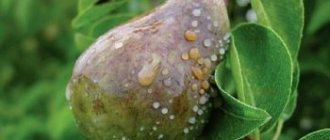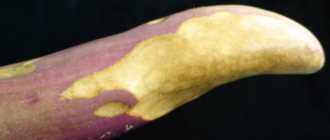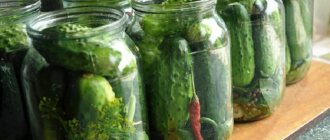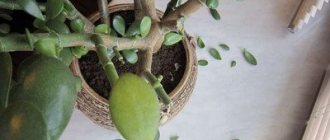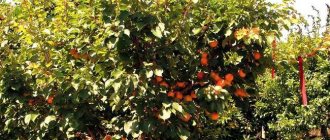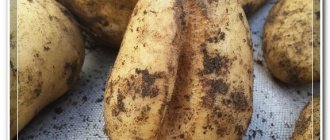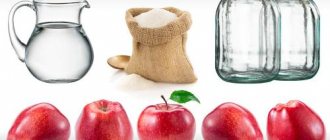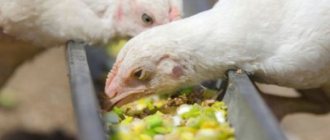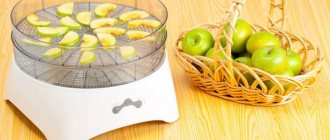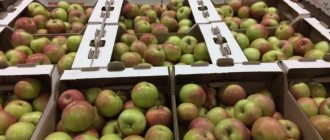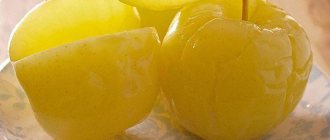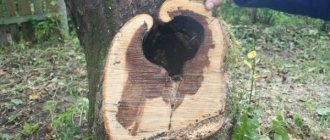This problem is familiar to every gardener. Almost every garden has at least once seen such a sad sight of apples rotting right on the tree . This attack is called “brown fruit rot ” or scientifically “ moniliosis ”. It is extremely difficult to cope with it, but you can make sure that every year the damage from it becomes less. And if you listen to our advice, then the question: “ What to do if the apples rot on the tree?” , will never baffle your brain again.
Apples rot right on the tree: Causes and signs
Reason
The fact that
apples rot right on the tree
is a very persistent fungus. Its spores overwinter in damaged branches or in the ground, and are then carried by wind or insects, infecting new apple trees during flowering.
Notice! This infection affects not only apple trees, but also pears, quinces, and stone fruits: apricots, peaches, cherries, sweet cherries, cherry plums.
How to recognize moniliosis
The disease appears on the fruit in the form of small brown spots, and then affects the entire apple. At the final stage, the entire fruit is covered with yellowish-gray pimples arranged in concentric circles. These are fungal spores called conidia.
Further infection of healthy apples with moniliosis occurs through the stalk, through contact with a diseased fruit or the wind. For infection, damage must be present, which occurs due to damage by the codling moth or hail. Wasps and birds, who are not averse to enjoying free delicacies, also contribute, as well as:
- scab;
- flycatcher;
- and chlorosis.
But all this is already the second stage of the disease. The first stage of moniliosis coincides with flowering, but not all gardeners are aware that this is the same scourge. First, the flowers dry out and fall off, then the leaves and branches are affected. The twisted brown leaves do not fall off, but remain hanging on the branches. The branches themselves appear to be burnt.
Gardeners usually blame this on lack of moisture, improper spraying, or hot weather. In fact, this is the same fruit rot , which can almost completely destroy the crop if immediate measures are not taken.
The main causes of rot
The cause of apple rot is considered to be fungal diseases. In addition to fruits, they damage leaves and young shoots. The disease mainly spreads on trees whose fruits have seeds and seeds. Fungal spores are carried by the wind from one tree to another, exposing it to fruit rot.
Moniliosis - treatment: urgent measures
Now that it is clear why apples rot on trees
, it’s time to decide
what to do
with this scourge and how to treat moniliosis.
As soon as drying of the leaves is noticed, it is necessary to remove the affected branches. You should cut off 10-15 centimeters more than the disease has managed to capture. It is better to burn all cut branches immediately, and if this is not possible, then leave them in a bucket, be sure to cover it with a lid. Place the fallen flowers there too, because they are also infected with disease spores. But it is not advisable to put them in compost. Disputes can persist in it for a long time.
Important! If you want the treatment of apple tree moniliosis to be quick and effective, then you should not delay spraying.
To do this, make a 1% solution of Bordeaux mixture and carefully treat not only the branches that have been affected by the disease, but also the entire tree. This may require about 3 liters of liquid. If you don’t want to use chemicals, then you can buy industrial fungicides to combat moniliosis . In spring, in cool weather, it is better to spray with Horus. It is the most effective and harmless to bees.
There are other fungicides:
- "Skor" or "Kaptan".
- "Raek" or "Delan".
- "Abiga Peak"
- "Polyram"
- "Topsin-M" and others.
It should be noted that “Horus” is recommended to be used in cool weather, and in hot weather during fruit growth it is better to use “Skor”.
On a note! All these fungicides are not dangerous to people and animals, including bees, although fruit treatment should be carried out two weeks before harvest, or better yet a month.
To prevent apples from rotting on the tree , you can use the following chemicals that kill fungal spores:
- colloidal sulfur;
- copper oxychloride (Hom);
- copper sulfate.
There are also biological products to combat moniliosis and other fungal diseases:
- "Fitosporin M"
- "Mikosan V";
- "Alirin B."
! They suppress the development of spores and are harmless to people, pets and bees.
Ways to fight diseases
There are many ways to combat fruit rot. Control and treatment measures include:
- carrying out preventive measures;
- digging the soil and treating it with copper sulfate;
- fertilization;
- treating trees with special chemicals;
- compliance with the rules of planting seedlings.
When the first signs appear on trees, they should be treated.
Folk remedies for apple tree moniliosis
Folk remedies are also known:
- mustard solution;
- a mixture of iodine, potassium permanganate and soda;
- table salt solution.
To prepare a mustard solution you will need 40 g of dry powder per bucket of water. You need to take 1 kg of salt for the same amount of water. The tree is sprayed with these even shortly before harvesting.
The disadvantage of these methods is that they are ineffective, so the processing will have to be repeated several times.
The second recipe is much more effective against rotting apples on the branches..
- To prepare this product, take 4 tablespoons of baking soda and dissolve it in a liter of warm water at a temperature of 50°C. Then add 15-20 drops of iodine tincture and pour it into a bucket of water.
- Separately prepare a solution of potassium permanganate, pouring enough of it to form a purple liquid. It is also added to the previously obtained solution. Finally, you need to pour 3 tablespoons of liquid soap or dishwashing detergent into it so that the liquid evenly moistens the fruits and leaves.
- Soap can also be added to previous mixtures. The advantage of folk remedies is that they can be used shortly before harvest. You just need to wash the apples well before consuming them as food or making homemade preparations for the winter to rid them of the soapy taste.
To apples
not
rot on the tree
, you need to fight the moth. Folk remedies such as infusion of wormwood, hogweed, henbane or hemlock can help with this. The last two plants are poisonous, so they are used at least a couple of weeks before harvest.
Interesting and useful! To repel codling moths, it is useful to tie wormwood branches to apple tree branches during flowering. Butterflies do not like its smell, so these winged ones will fly to lay eggs in another place more suitable for them.
How to spray apple trees correctly
To properly spray trees, you need to use the right product in the right concentration, for which it is important to carefully study the instructions for the product. It is important to use equipment suitable for processing.
Spray bottles or hand sprayers with a pump are best.
The spray head should be located on a long boom, which will allow you to spray high crowns. Apple trees must be treated on all sides, and the soil under them must be sprinkled. When carrying out work, you must wear a protective suit and mask to avoid poisoning or chemical burns.
Apples rot on the tree: prevention of fruit rot
An important preventive measure is the timely collection and burning of affected fruits, carrion and fallen leaves.
Treatment of diseased trees
To quickly rid the apple kingdom of a harmful fungus, you will have to fight it, starting in spring and ending in late autumn. In early spring, after the snow has melted, but before the buds open, the trees and the soil under them are treated with 3% Bordeaux mixture or copper sulfate. If you do not have time to carry out the treatment at this time, then you need to spray with a weaker, 1% solution.
In the fall, after harvesting and leaf fall, it is better to use iron sulfate instead of copper sulfate. With this preparation you need not only to spray the trees generously, but also to water the soil under them.
Advice! See if the apples on your neighbors trees are rotting. If they suffer the same problem, then they need to be treated together, and preferably at the same time, since the spores easily infect trees in windy weather.
Fighting chlorosis
Pay attention to the leaves of apple trees in the spring. If chlorosis appears, then it is necessary to feed the apple tree as quickly as possible.
Which mineral substances trees lack can be determined by the color of the leaves:
- If the leaves begin to turn pale on the underside of the leaves, this indicates a lack of nitrogen.
- If the leaves located closer to the center of the shoot become lightened, the tree does not have enough potassium.
- If the leaves on the tops of the shoots begin to turn yellow, then this is a sign of iron deficiency.
- Leaves with brown spots indicate a lack of magnesium and manganese.
It is better to fertilize not only the root, but also spray the leaves, using a solution three times less concentrated.
To prevent chlorosis, the soil under trees should be dug up in spring and autumn at the same time as humus, compost and mineral fertilizers are added.
Attention! The digging depth should be no more than 15 cm so as not to damage the roots of the apple tree.
Apples rot right on the tree, prevention: Pruning apple trees
It is worth starting pruning as early as possible in the spring. Since the disease primarily affects branches located in the shaded inner part of the crown (this is where apples rot on the tree first), branches growing inward should be removed. Sunlight and good ventilation of foliage significantly reduce the incidence of moniliosis in fruits.
Before pruning and immediately after it, the tool should be thoroughly disinfected. All cut points must be immediately covered with garden varnish. They should also treat all damage to the bark, which is the gateway for infection.
Characteristic signs of rotting
Signs of apple rot vary depending on the causes of its occurrence. The following are characteristic of moniliosis:
- worm carrions are present;
- the pulp of the affected fruit becomes soft;
- rotting begins with a small dark spot;
- rot fills most of the apple;
- Over time, the fruit begins to turn completely black without falling to the ground, which infects its “neighbors.”
Manifestations of moniliosis
One apple can infect the rest of the fruits, and then the entire tree. The moniliosis fungus tolerates the winter well, and in the spring it will begin to infect the plant again. The young elm will fade and the branches will deteriorate. Apples of summer varieties are most susceptible to the disease.
Chlorosis indicates a deficiency of a particular substance in the tree. This manifests itself as follows:
- yellow leaves at the top of the shoots indicate a lack of iron;
- if there is not enough nitrogen, the leaves and lower parts of the branches will be pale;
- lightened foliage in the center of the shoot is a sign of potassium deficiency;
- a lack of magnesium and manganese is manifested by brown spots on the leaves.
Scab is characterized by many manifestations and the main ones are:
- single dry leaves that appear deformed or covered with black spots;
- the appearance of black dots in one place of the apple or throughout the fruit;
- mummification of unripe apples, which then fall to the ground;
- the fruit pulp darkens and softens;
- Grayish dots appear on the rotting surface.
Scab on an apple
Some gardeners do not pay attention to the moment when the tops of the trees begin to dry out in early spring. They mistakenly believe that this is a return of frost or the result of improper spraying. You can distinguish fruit rot from other causes of tree damage if you look closely at the flowers. They are the ones who begin to dry out first, then the leaves, and immediately after them the branches themselves. This is explained by the fact that the fungus enters the plant at the time of its flowering.
Other hazards
Moniliosis appears due to a combination of circumstances and is often a concomitant disease. People who grow apple trees note that you need to be on guard if the tree has suffered:
- chlorosis;
- scab;
- fly eater
These infections appear due to a lack or excess of micro- and macroelements in the soil.
Chlorosis occurs due to iron deficiency in the soil. The problem is corrected by adding a solution of iron sulfate at the rate of 300 g per 10 liters. This mixture is used to water the hole under the tree in late autumn, when the leaves have already fallen.
Against scab, summer residents recommend the fungicide “Skor” and a 10% solution of ammonium nitrate. Fly pests appear due to the large amount of nitrogen in the soil. Enough with standardized fertilizer and monitoring the humidity level. It shouldn't be too high.
Spraying with specialized products
To prevent various diseases, it is recommended to spray apple trees using chemical protective agents. First, trees are treated before apple trees bloom.
The following drugs are used:
- "Mikosan-V";
- "Horus";
- Bordeaux mixture;
- "Meters";
- colloidal sulfur;
- "Strobe";
- "Abiga Peak";
- "Agricola";
- "Ferovit";
- "Raek";
- "Vectra";
- "Fludioxonil";
- "Phytoflavin".
The next treatment is carried out immediately after the apple trees bloom with the same means. Then again in July. After harvesting, it is advisable to spray the trees again with Bordeaux mixture, as it contains copper.
How to understand that a tree is sick
The initial signs of the disease are comparable to the reaction of an apple tree to late frosts: new shoots, young leaves and flowers dry out. The order in which the shoots die is considered a distinctive sign. In case of illness:
- first the flowers dry up;
- then only leaves and other shoots.
There is also a burn form of moniliosis. The branch looks the part, as if burned. If rot immediately attacks the apples, they turn brown. First of all, the damage zones turn brown:
- dents;
- cracks;
- places eaten by insects.
The last stage is the growth of the mushroom layer on the apple. Pillows of a dirty yellow hue form in circles around the fruit, ringing it completely.
Preventive actions
To prevent diseases, it is necessary to apply basic measures to protect apple trees from fruit rotting:
- Rake and burn dry leaves after leaf fall.
- Carry out sanitary pruning of the crown with preliminary disinfection of garden tools.
- Place the seedlings loosely, allowing air to circulate between the trees.
- Avoid injuring apple trees, and treat cracks and cuts with garden varnish.
- Digging up the ground under the crown of trees.
Autumn-spring treatment
In the spring and autumn, as a preventative measure, it is recommended to treat apple tree trunks with lime with the addition of universal fungicides. At the same time, it is worth removing dry dead branches and removing plant debris from under the crown. The soil under the tree should be dug up and fertilized, which will help avoid chlorosis during the current or next season.
It is worth considering that when spraying before and after the growing season, it is worth treating both the crown and the ground underneath it.
What to do with rotten fruit
Under no circumstances should spoiled fruit be left on apple trees or the ground underneath them, even if the entire space has been treated with chemicals. Some of the spores will remain viable, and with the wind they will fall on healthy trees or re-infect apples. Rotten fruits should not only be taken away from the garden, but also not left in the open air. It is advisable to bury the apples or burn them on fire.
See also
Description and characteristics of Granny Smith apples, features of planting and care
Read
Selection of disease-resistant varieties
There are no fruit trees that are completely resistant to fungal diseases. There are varieties that are much less likely to be infected with moniliosis.
These varieties are:
Apple varieties with strong immunity against chlorosis:
Apple varieties that resist scab:
- Lungwort;
- Delight;
- Orlinka;
- Star;
- Moscow winter;
- Saffron pepin;
- Margo;
- Orpheus.
The following apple varieties are most protected from fly beetles:
- Manchurian;
- Blood red;
- Siebold;
- Abundantly flowering;
- Aldenham Purple.
Apple fruit rot
Manifests itself in two stages:
- Spring - “monilial apple tree burn”, (Monilia cinerea Bon). Causes death of peduncles and flowers, damage to branches and drying out;
- Autumn - “fruit rot” (Monilia fructigena Pers.). Causes damage to ripening apples, reduces yield and shortens shelf life.
Monilial burn of an apple tree.
The disease affects apple orchards, causing enormous damage to the condition of the plants, as well as the quality and size of the harvest.
